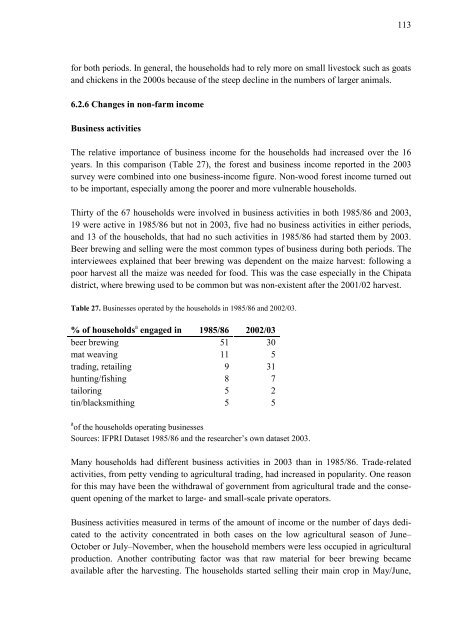Rural Income Generation and Diversification - A Case Study ... - Doria
Rural Income Generation and Diversification - A Case Study ... - Doria
Rural Income Generation and Diversification - A Case Study ... - Doria
Create successful ePaper yourself
Turn your PDF publications into a flip-book with our unique Google optimized e-Paper software.
for both periods. In general, the households had to rely more on small livestock such as goats<br />
<strong>and</strong> chickens in the 2000s because of the steep decline in the numbers of larger animals.<br />
6.2.6 Changes in non-farm income<br />
Business activities<br />
The relative importance of business income for the households had increased over the 16<br />
years. In this comparison (Table 27), the forest <strong>and</strong> business income reported in the 2003<br />
survey were combined into one business-income figure. Non-wood forest income turned out<br />
to be important, especially among the poorer <strong>and</strong> more vulnerable households.<br />
Thirty of the 67 households were involved in business activities in both 1985/86 <strong>and</strong> 2003,<br />
19 were active in 1985/86 but not in 2003, five had no business activities in either periods,<br />
<strong>and</strong> 13 of the households, that had no such activities in 1985/86 had started them by 2003.<br />
Beer brewing <strong>and</strong> selling were the most common types of business during both periods. The<br />
interviewees explained that beer brewing was dependent on the maize harvest: following a<br />
poor harvest all the maize was needed for food. This was the case especially in the Chipata<br />
district, where brewing used to be common but was non-existent after the 2001/02 harvest.<br />
Table 27. Businesses operated by the households in 1985/86 <strong>and</strong> 2002/03.<br />
% of households a engaged in 1985/86 2002/03<br />
beer brewing 51 30<br />
mat weaving 11 5<br />
trading, retailing 9 31<br />
hunting/fishing 8 7<br />
tailoring 5 2<br />
tin/blacksmithing 5 5<br />
a of the households operating businesses<br />
Sources: IFPRI Dataset 1985/86 <strong>and</strong> the researcher’s own dataset 2003.<br />
Many households had different business activities in 2003 than in 1985/86. Trade-related<br />
activities, from petty vending to agricultural trading, had increased in popularity. One reason<br />
for this may have been the withdrawal of government from agricultural trade <strong>and</strong> the consequent<br />
opening of the market to large- <strong>and</strong> small-scale private operators.<br />
Business activities measured in terms of the amount of income or the number of days dedicated<br />
to the activity concentrated in both cases on the low agricultural season of June–<br />
October or July–November, when the household members were less occupied in agricultural<br />
production. Another contributing factor was that raw material for beer brewing became<br />
available after the harvesting. The households started selling their main crop in May/June,<br />
113

















